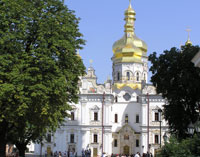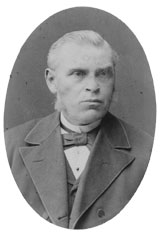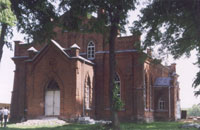About Their Faith
 Christianity first made its entrance into Ukraine, and eventually Russia, through the gates of Kiev on the banks of Dneiper River in 988 AD. That same year that Prince Vladimir embraced Christianity and established the Russian Orthodox Church as the state religion. It was not for another 800 years, however, that the Protestant church made its appearance in Volhynia. The oldest and largest of the Protestant groups was the Evangelical Lutheran Church. The first parish was established in the Zhitomir region in 1801. It spread widely and rapidly. By the middle of the 19th century it was a most imposing institution. Because of its monumental size, missionary outreach, and benevolent endeavors, it had almost a monopoly on Protestant life in Volhynia. It operated an extensive parochial school system, with about as many schools as churches, and a training school for teachers, which was located in Heimtal.
Christianity first made its entrance into Ukraine, and eventually Russia, through the gates of Kiev on the banks of Dneiper River in 988 AD. That same year that Prince Vladimir embraced Christianity and established the Russian Orthodox Church as the state religion. It was not for another 800 years, however, that the Protestant church made its appearance in Volhynia. The oldest and largest of the Protestant groups was the Evangelical Lutheran Church. The first parish was established in the Zhitomir region in 1801. It spread widely and rapidly. By the middle of the 19th century it was a most imposing institution. Because of its monumental size, missionary outreach, and benevolent endeavors, it had almost a monopoly on Protestant life in Volhynia. It operated an extensive parochial school system, with about as many schools as churches, and a training school for teachers, which was located in Heimtal.
 But the Baptists were not to be out done. They made their appearance in Volhynia in the early 1860s and established the first Baptist church in Horstschick in 1864. The Baptist movement in Russia was largely the result of the missionary efforts of Gottfried F. Alf (1831-1898), progenitor of Baptists in Poland, as well as the German Baptists in the Russian Empire. He was the first Baptist person to be baptized in Poland and the first Baptist missionary to Russia. Alf, never one to miss a mission opportunity, made numerous trips to Volhynia to plant churches and encourage the brethren, who had left his church in Adamowo, Poland.
But the Baptists were not to be out done. They made their appearance in Volhynia in the early 1860s and established the first Baptist church in Horstschick in 1864. The Baptist movement in Russia was largely the result of the missionary efforts of Gottfried F. Alf (1831-1898), progenitor of Baptists in Poland, as well as the German Baptists in the Russian Empire. He was the first Baptist person to be baptized in Poland and the first Baptist missionary to Russia. Alf, never one to miss a mission opportunity, made numerous trips to Volhynia to plant churches and encourage the brethren, who had left his church in Adamowo, Poland.
 While the Baptists never numbered more than 15,000 baptized members, they were an extremely fervent and formidable force. Because of their evangelistic zeal, emphasis on the new birth experience, separation from the world and believer’s baptism, they often clashed with the more institutional nature and structure of the Lutheran and Orthodox churches and its pastors.
While the Baptists never numbered more than 15,000 baptized members, they were an extremely fervent and formidable force. Because of their evangelistic zeal, emphasis on the new birth experience, separation from the world and believer’s baptism, they often clashed with the more institutional nature and structure of the Lutheran and Orthodox churches and its pastors.
Other religious groups included the Mennonites, Moravians, Seventh Day Adventists, the Church of God and the Stundist sect. The Stundists were comprised primarily of people who continued as adherents of their own churches, but met in homes for one or more hours (Stunden in German) for singing, prayer and Bible reading.